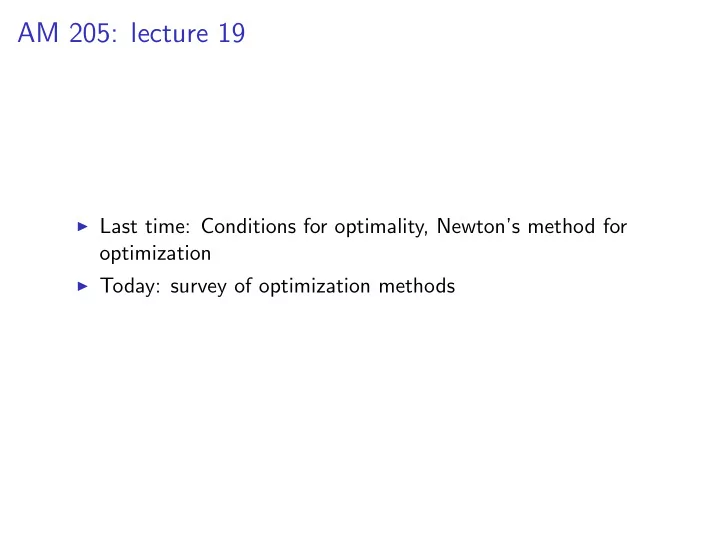

AM 205: lecture 19 ◮ Last time: Conditions for optimality, Newton’s method for optimization ◮ Today: survey of optimization methods
Newton’s Method: Robustness Newton’s method generally converges much faster than steepest descent However, Newton’s method can be unreliable far away from a solution To improve robustness during early iterations it is common to perform a line search in the Newton-step-direction Also line search can ensure we don’t approach a local max. as can happen with raw Newton method The line search modifies the Newton step size, hence often referred to as a damped Newton method
Newton’s Method: Robustness Another way to improve robustness is with trust region methods At each iteration k , a “trust radius” R k is computed This determines a region surrounding x k on which we “trust” our quadratic approx. We require � x k +1 − x k � ≤ R k , hence constrained optimization problem (with quadratic objective function) at each step
Newton’s Method: Robustness Size of R k +1 is based on comparing actual change, f ( x k +1 ) − f ( x k ), to change predicted by the quadratic model If quadratic model is accurate, we expand the trust radius, otherwise we contract it When close to a minimum, R k should be large enough to allow full Newton steps = ⇒ eventual quadratic convergence
Quasi-Newton Methods Newton’s method is effective for optimization, but it can be unreliable, expensive, and complicated ◮ Unreliable: Only converges when sufficiently close to a minimum ◮ Expensive: The Hessian H f is dense in general, hence very expensive if n is large ◮ Complicated: Can be impractical or laborious to derive the Hessian Hence there has been much interest in so-called quasi-Newton methods, which do not require the Hessian
Quasi-Newton Methods General form of quasi-Newton methods: x k +1 = x k − α k B − 1 k ∇ f ( x k ) where α k is a line search parameter and B k is some approximation to the Hessian Quasi-Newton methods generally lose quadratic convergence of Newton’s method, but often superlinear convergence is achieved We now consider some specific quasi-Newton methods
BFGS The Broyden–Fletcher–Goldfarb–Shanno (BFGS) method is one of the most popular quasi-Newton methods: 1: choose initial guess x 0 2: choose B 0 , initial Hessian guess, e.g. B 0 = I 3: for k = 0 , 1 , 2 , . . . do solve B k s k = −∇ f ( x k ) 4: x k +1 = x k + s k 5: y k = ∇ f ( x k +1 ) − ∇ f ( x k ) 6: B k +1 = B k + ∆ B k 7: 8: end for where ∆ B k ≡ y k y T − B k s k s T k B k k y T s T k s k k B k s k
BFGS See lecture: derivation of the Broyden root-finding algorithm See lecture: derivation of the BFGS algorithm Basic idea is that B k accumulates second derivative information on successive iterations, eventually approximates H f well
BFGS Actual implementation of BFGS: store and update inverse Hessian to avoid solving linear system: 1: choose initial guess x 0 2: choose H 0 , initial inverse Hessian guess, e.g. H 0 = I 3: for k = 0 , 1 , 2 , . . . do calculate s k = − H k ∇ f ( x k ) 4: x k +1 = x k + s k 5: y k = ∇ f ( x k +1 ) − ∇ f ( x k ) 6: H k +1 = H k + ∆ H k 7: 8: end for where 1 ∆ H k ≡ ( I − s k ρ k y t k ) H k ( I − ρ k y k s T k ) + ρ k s k s T ρ k = k , y t k s k
BFGS BFGS is implemented as the fmin bfgs function in scipy.optimize Also, BFGS (+ trust region) is implemented in Matlab’s fminunc function, e.g. x0 = [5;5]; options = optimset(’GradObj’,’on’); [x,fval,exitflag,output] = ... fminunc(@himmelblau_function,x0,options);
Recommend
More recommend